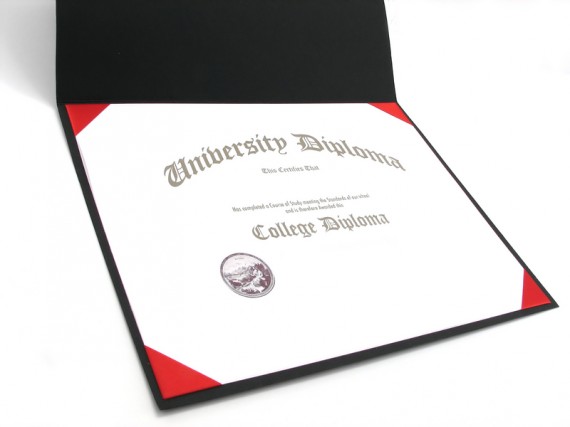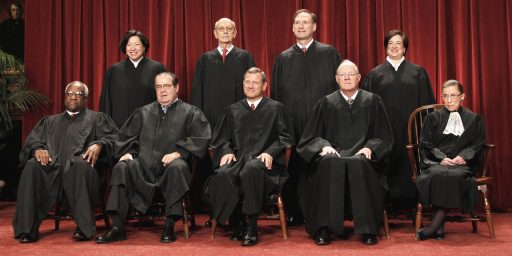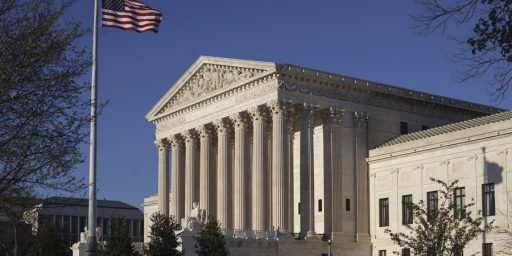Supreme Court Agrees To Wade Back Into The Affirmative Action Debate
The Supreme Court agreed yesterday to wade back into the thorny issue of race and higher education.
In addition to handing down the final opinions of its term, the Supreme Court yesterday agreed to wade yet again into the thorny issue of affirmative action in higher education admission, accepting for appeal a case related to one that it had heard two years ago but largely avoided ruling on the merits:
WASHINGTON — The Supreme Court agreed on Monday to take a second look at a challenge to the use of race in admissions decisions by the University of Texas at Austin, reviving a potent challenge to affirmative action in higher education.
When the court last considered the case in 2013, supporters of affirmative action were nervous. But the court kicked the can down the road in what appeared to be a compromise decision.
In returning to the case, the court signaled that it might be prepared to issue a major decision on the role race may play in government decision making.
In 2013, Justice Anthony M. Kennedy, writing for the majority, said the appeals court had been insufficiently skeptical of the program, which has unusual features. The appeals court then endorsed the program for a second time.
Most applicants from Texas are admitted under a part of the program that guarantees admission to the top students in every high school in the state. (This is often called the Top 10 program, though the percentage cutoff can vary by year.)
The Top 10 program has produced significant racial and ethnic diversity. In recent years, about 25 percent of freshmen who enrolled under the program were Hispanic, and 6 percent were black.
The remaining Texas students and those from elsewhere are considered under standards that take account of academic achievement and other factors, including race and ethnicity. Many colleges and universities admit all of their students on such “holistic” grounds.
In 2003, in Grutter v. Bollinger, the Supreme Court endorsed such holistic admissions programs, saying it was permissible to consider race as one factor of many to achieve educational diversity. Writing for the majority in the Grutter case, Justice Sandra Day O’Connor said she expected that “25 years from now,” the “use of racial preferences will no longer be necessary.”
The question in the Texas case was whether its flagship state university was entitled to supplement its race-neutral Top 10 program with a race-conscious holistic one.
The Supreme Court’s 2013 decision in Fisher v. University of Texas reaffirmed that educational diversity is an interest sufficient to overcome the general ban on racial classifications by the government. But it added that public institutions must have good reasons for the particular methods they use to achieve that goal.
Colleges and universities, Justice Kennedy wrote, must demonstrate that “available, workable race-neutral alternatives do not suffice” before using race in admissions decisions.
After the Justices remanded what I suppose must now be called Fisher I to the lower courts, the Fifth Circuit ended up upholding the University’s admission plan:
Last year, in its second encounter with the case, a divided three-judge panel of the United States Court of Appeals for the Fifth Circuit, in New Orleans, ruled that the Texas admissions plan satisfied strict scrutiny.
“We are persuaded that to deny U.T. Austin its limited use of race in its search for holistic diversity would hobble the richness of the educational experience,” Judge Patrick E. Higginbotham wrote for the majority.
The Top 10 program is inadequate, he said, because it is a blunt instrument and a product of the fact that many Texas high schools are largely segregated.
“While the Top 10 percent plan boosts minority enrollment by skimming from the tops of Texas high schools,” Judge Higginbotham wrote, “it does so against this backdrop of increasing resegregation in Texas public schools, where over half of Hispanic students and 40 percent of black students attend a school with 90 percent-100 percent minority enrollment.”
In dissent, Judge Emilio M. Garza said the university’s justifications for using race were “subjective, circular or tautological.”
Lyle Denniston puts what is likely to be one of the most high-profile cases of the next term into perspective:
The new review of the University of Texas case, like the Court’s prior ruling on it two years ago, will be made by an eight-member Court. Justice Elena Kagan is again not taking part, probably because she was serving in the Obama administration when it was involved in the Texas case earlier.
After the Court, in its seven-to-one ruling in 2013, told the U.S. Court of Appeals for the Fifth Circuit to apply a more demanding analysis to the Texas plan, the Fifth Circuit once again upheld it, rejecting the challenge by Abigail Fisher, the white woman from Sugar Land, Texas, who has claimed that the university denied her application for admission five years ago because of her race.
Fisher’s lawyers filed a new appeal, arguing that the Fifth Circuit did not carry out the Court’s orders, and that it actually introduced a new level of race bias into the admissions process by accepting the view that students who graduated from racially segregated high schools in Texas lack sufficient educational qualifications to contribute to racial diversity at the university.
Fisher’s petition put its primary focus on the claim that the Fifth Circuit once again deferred to university officials’ argument that they needed to use race as one factor in making admissions decisions, when the Supreme Court had ordered the appeals court to independently judge the need for any use of race.
The university actually uses two plans in choosing its incoming class. First, it assures automatic admission to any student who graduated in the top ten percent scholastically of the graduating class at a Texas high school. That mode has controlled about eighty percent of first-year admissions. Second, to fill the remaining seats, the university judges a wide array of applicants’ qualifications, and at that point does take race into account as one factor among them.
The new appeal argued that the Fifth Circuit, in concluding that the university did need to go to the second formula, based that view upon its discriminatory perception of the educational promise of students admitted under the so-called Top Ten Percent Plan. That, the petition contended, “is the very ill that the Equal Protection Clause [of the Fourteenth Amendment] seeks to banish.
While the new petition does not explicitly ask the Court to overrule the Grutter precedent, it suggested that, if the Texas plan is found to satisfy the Grutter decision, then that precedent should be reexamined and overruled. The customary rule of respecting prior precedent, Fisher’s lawyers argued, has less force when an issue of race is involved.
The Court will hold oral argument in the case, perhaps next December, and will decide it later in the new Term.
The whole issue of affirmative action in higher education has been one that the Justices have, often reluctantly, dealt with for nearly forty years now and that they’ve generally succeeded in doing is dancing around the edges of the issue without really coming down on one side or the other. The dancing started with Regents of the University of California v. Bakke in 1978. While the Court did not fully reject the idea of race-based admissions policies in Bakke, it also didn’t completely approve it either, a mixed holding that seemed to suggest that universities could have policies that took race and ethnicity into account but that anything that resembling quotas. The problem was that the opinion wasn’t very specific about where the difference between permissible race conscious and impermissible quotas might actually lie. What followed the Bakke decision was a long era in which admissions authorities tried to determine what exactly is acceptable under the 14th Amendment’s Equal Protection Clause which, as a general rule, bars race-based discrimination by government entities, including public universities. The Court didn’t provide much guidance on the issue in the intervening years until a 2003 case called Grutter v. Bollinger where the Court upheld an affirmative action policy in place at the University of Michigan Law School that used race as a factor with the purported goal of increasing class diversity. The decision still didn’t necessarily resolve many of the questions left by Bakke and it especially left many conservatives unsatisfied to the point where many hoped that the opportunity to deal with the issue head-on would finally arrive once Justice Sandra Day O’Connor, who was the deciding vote in Grutter, retired. This is why the original Fisher case received so much attention since it was seen as an opportunity to at least significantly curtail the ability of public universities to use race as an admissions criteria. When the Court issued its opinion, though, it was one that didn’t really satisfy either side since all it really did was punt the issue back to the lower courts. In the intervening years, it’s been reported but not confirmed that Justice Kennedy had drafted an opinion that would have widely rejected most of the University of Texas’s program but he was unable to hold a majority together. Now, the case will be back before the Court.
One anticipates that the Justices won’t be able to punt this case as they did in 2013, so there’s going to be some kind of ruling on the merits. In that respect, it’s important to note that Justice Kagan will once again not be participating in the consideration of this case given the fact that she was involved with the Federal Government’s handling of it when she served as Solicitor General before being elevated to the Court. Strictly from a nose counting perspective, this would seem to be bad news for the University of Texas since Kagan would be expected to vote with Justices Ginsburg, Sotomayor, and Breyer on the underlying issues in these cases and Justice Kennedy has previously expressed skepticism over race-based admissions programs as evidenced by the fact that he was in the minority in Grutter that would have struck down the University of Michigan’s program. This is the same dynamic that existed the last time the Court heard the case, of course, so its unclear what that means going forward, but it seems likely that a decision that restricts Grutter or even overturns it outright is not beyond the realm of possibility. In any case, this case will be argued early in the October 2015 Term, but if 2013 is any indication it could be many months before the Court hands down a decision.







This case has reached a point where it seems to be a theoretical exercise. The plaintiff has now graduated college (LSU). I’m not sure what the remedy would be at this point.
Regardless, a couple of points which may be or not germane to the legal aspects of the case.
1) I think the solution would be to use socioeconomic class as a criteria rather than race. I think the desired diversity would be approximately the same although I have no basis for that statement.
2) The competition for top schools (UT is in that category) is so great today that many good students cannot get in. In fact, a lot of parents that went to UT would not be able to get in today.
3) In Texas, the desire of parents for their children to go to their alma mater is high creating a lot of political pressure on the schools.
4) Many of these parents believe that legacy admittance should be used and that this is not a form of affirmative action.
All these factors created a lot of resentment among certain classes of Texans.
@Scott
This is an idea I’ve heard from many circles in recent years, including some African-Americans who point out the oddity in giving an Afircan-American from an Upper Middle Class family the same kind of “preference” that one gives to a kid from the inner city.
To help with the discussions
A link to a short explanation to the Top10% rule cite The law mandates that all state universities except UT-Austin must admit all students who finished in the top 10% of their graduating class while UT-Austin must admitted the highest ranking students until it fill 75% of its instate entering class.
The top 10% rule came about after the Hopwood decision cite but was before the US News lists had become dominant. I doubt if the the authors of the top 10% rule anticipated that all of the focus would be on UT-Austin.
What almost all holistic admissions programs do is cause the university to be more ruthless somewhere else. At UT-Austin it comes in being admitted to certain majors or colleges. In other words, UT-Austin may be admitting poor students from rural or inner city schools using top 10% rule or holistic review but those same students do not get to major in Business or Engineering with out the high school course work, SAT scores, and other hard numbers.
A real question for all of the diversity uber alles types should be to explain how a black or Latino student would be better off majoring in ethnic studies or sociology at UT-Austin rather than accounting, nursing, or even engineering at Texas Tech, Houston, or North Texas?
To a certain extent AA is trying to solve the problem of getting clean water from the tap by fiddling with the tap and pretending that someone is not poisoning the well. Roberts in particular, seems to be in denial that the well is still being poisoned. And fixing the well is going to be costly.
Does Texas have anything like an equitable, fair public school system in which everyone has a chance for a good education and thus a good chance at competing for college admissions ?H3ll no! It’s just as much a racial caste educational system as it ever was. Is Texas even interested in fixing it’s school system? I don’t even think it will admit it has a problem.To the extent it admits it, it’s attitude to fixing the problem is probably ¯\_(ツ)_/¯, along with blaming blacks and Hispanics for “cultural problems” (Why can’t they be like the Asians? )
Yup. Every conservative screed about AA skips over legacy admissions. They hammer away about meritocracy and what a shame it is for deserving white students to be displaced until legacy admissions are brought up, and then they get very understanding about the “need” for parents to continue traditions, etc.
Roberts has a “h@rd on” for affirmative action, and think he wants to deep six it once and for all. As to what to put in is place or how to solve the underlying problem, he has no idea. But he does want to get rid of AA.
@superdestroyer:
I think it’s obvious that an individual would, in fact, be better off by going the academic route, provided they have the chops. I also think it’s obvious that academia benefits from diversity. Also obvious, some folks would be better off in the trades.
I think your question, though, has a fatal flaw. “Diversity uber alles.” It may seem like the ultimate goal of the, ahem “Diversity uber alles” crowd is to create diversity. Like that’s the end game, rainbows everywhere.
But that’s not it. Diversity is not the goal. It’s the means. The goal, of course, is human welfare. Are you to have us believe that your concern for white people has been displaced by a larger concern for humanity in general?
I am unaware of a case where a white plaintiff has sued a university because another presumably less qualified white student was granted admission ahead of him/her.
Is the general presumption that only less qualified minority students are admitted ahead of a more qualified white students?
@al-Ameda: Actually, in this case, 42 white students with lesser grades and test scores were granted admission ahead of the plaintiff.
http://www.propublica.org/article/a-colorblind-constitution-what-abigail-fishers-affirmative-action-case-is-r
@Doug Mataconis: I’ve actually been saying the same thing for about 20+ years, and I certainly wasn’t the first person to think about it.
@Franklin: One can make a case that Republicans are indeed past race, that they are biased against all poor people, regardless of race, creed, or color.
Getting into college is a first step, but it can be the door opener to future success. I was friends with a guy who was an excellent performer in the hundred meters in high school. He got into a fairly elite university in the southern Atlantic states on that basis; his grades and SAT scores would probably have not gotten him in, and they certainly would not have gotten him the financial aid his track performance got. After graduation, he got a bunch of good job offers in that state on the basis of having lettered in a varsity sport which he turned down in favor of returning to the NYC area. His chance to go to a fancy school on Tobacco Row and start with a good job in that state was not based on his scholastic skill.
People get launched based on scholastic skill, some because of athletics, some get special affiliation scholarships, etc. Getting in is not basely on scholarship versus AA. The biggest non-scholastic factor in admissions are legacies which are very important at the most elite schools; I have read that 25-30% of admissions to Princeton, Yale, and Harvard are legacies. Sprinkling in a few Sotomayors into this mix probably does not hurt much.
So the Supremes agree yet again to hear a totally frivolous claim that seeks $100.00 in damages for a girl that was denied entrance to UT as a slightly better than mediocre student.
These stories always remind me of a TV news story years ago. An affirmative action admissions case. The plaintiff was a very attractive, very bright young lady who had done very well in school and on tests. She was interviewed at her parent’s home, obviously serious money. She was going on about how unfair it was that she was denied admission to her first choice school, Harvard or wherever. I’m afraid my reaction was, “Jeez lady, you really hit it big in the birth lottery. Is it really asking to much for you to leave something for somebody else?”
Wonder if it would help to email Roberts this link:
and the followup links.
I could then email him the pictures of the funeral in Charleston, South Carolina along with dates, just to impress on him that racism might just not be quite dead, just yet.
But I suppose that would just confuse him as he pushes on to his stated goal of ending affirmative action, So why I bother, I guess?
@Scott:
Thanks for the link. This was interesting:
What was unsaid is very interesting indeed.
@stonetools:
Texas schools perform above average for whites, blacks, and Latinos on the NAEP exams for 8th and 11th graders compared to several deep blue states such as California, Oregon, Washington, or Illinois. To blame the inability of blacks and Latinos who attend the good suburban schools such as Plano, Allen, Southlake Carroll, Katy, Conroe, or Austin Westlake to finish in the top 10% of their high school class due to funding in a common misconception. The top 10% of poor children are still doing to get admitted to UT-Austin even if they attend a poorly funded school. And UT-Austin has a program to baby sit those student to try to keep theschool’s graduation rate up even though its latest reported 4 year graduation rate was just 50%.
using race to determine who gets into any school is by definition “racist”. how do we have the nads to say we want to close the gaps on racial issues if we persist on having a “race” box on any application? if you have the grades to get into a certain school then that should be enough- unless you have a highly popular school without enough room for everyone- then they need to raise the bar i think? sure, you can throw in some extra-curricular things but grades are grades after all.
you white guilt people need to realize that you’re slowing down the very people you seem to want to help.
concerning ut-austin’s process; if a student isn’t accepted due to whatever factor (my kid had wicked grades, but went to a very large high school, so her’s were watered down compared to a small high school). instead of whining about it she went to another school in the system as they had to accept her after a successful year there. long story short- she graduated with honors at ut-austin after all.
@stonetools:
When it comes to the top 10% rule, white male is not the lowest difficulty setting. It is probably white female followed or even with Asian female. Since class rank is dependent on grades and taking AP/IB/Honors class for all four years, it is a program that benefits females who mature earlier than males and are less likely to have discipline problems. That girls are considered better students and get better grades in high school.
Many universities have to admit that they struggle to maintain an even gender ratio since they have more qualified female applicants than male applicants.
The top 10% rule helps a lot of rural districts also which don’t have the resources (not just money, but size and capabilities) of suburban schools, e.g. Honors and AP classes, SAT prep classes, etc.
The top 10% rule applies to all Texas Public Universities however, effectively, the competition is for UT-Austin and Texas A&M. Limiting UT-Austin to 75% automatic admittance will bring the percent down to the Top 8% in the coming year.
On this alone, this case should have never gotten as far as it did. She WAS accepted, albeit it conditional on her actually doing well in another school. If she earned her 3.59 GPA legitimately in high school, that shouldn’t have been an issue. So what if she has to go somewhere else for the basics as long as she gets her final UT degree? How many people got to a (cheaper) community college, knock off the easy courses and get their major in the desired (bigger name) college? Poor baby, forced to do the collegiate two-step because of her own mediocrity.
Any lawyer worth their salt should have pounded the hell out of that point to show it wasn’t that she wasn’t accepted, but not accepted on her desired terms. Shoulda hit the books a little harder, Abigail – 1180 is nothing to brag about and that’s her best score (you can take it multiple times and submit your best). You take the offer given to you since that’s what you earned – if you really want to go, a year’s no big and a possible cash saver!
@KM: I wouldn’t be too hard on the girl, I suspect she was led astray by her parents, family, and various people with agendas. She was used.
@Scott:
I’d be so inclined if she’d let this drop like Michalewicz did considering the winding path this case has taken. She is not a girl, she is a grown woman who at this point has made her own decision to stick with this. I’m giving her the dignity of her age (she was an adult even back then) and the benefit of the doubt. Led astray or not, she’s a capable adult who was smart enough to graduate from college – she chose to buy this garbage then and continues to buy it now when there is little tangible benefit for her to winning the case other then being “right”. She chose to sue instead of doing what anyone else in her shoes would have done, mainly go to the other college before moving on. She still chooses to sue – this is the second time before the Supreme Court. I cannot find pity for a woman so invested in beating a dead horse to prove something to herself she’ll push a case about admittance past her graduation. The only one using her now is herself.
Remember, once upon a time I worked in a college (thank god not Admissions!) I’m familiar with people like Fisher and her family. Can’t admit to themselves that their darling isn’t the big fish in a small pond anymore but rather the average specimen of humanity they are. Maybe it’s more humbling to have to take the two-step route, maybe it’s not the collegiate dream but its reality. Blaming things on AA is a way of avoiding the truth: genius, she ain’t. I cannot wait for the Supremes to reaffirm that.
@KM:
It is interesting that progressives keep wanting to discuss the exact credentials of Ms. Fisher instead of discussing the idea that a university that accepts public funds wants to have separate and unequal admission standards for white and Asian students versus black and Latino students.
What is also interesting is how progressive keep pushing the idea that actual learning, degree plans, and classes attended do no matter. What matters is that the public assumes that the dumbest students at UT-Austin is still smarter than the smartest student at Texas A&M.
@superdestroyer:
I’m a fan of doing away with AA and legacies in terms of admissions to college. I’m with Doug and Scott for a more practical system that takes socioeconomic status and need as a main determinate besides scholastic aptitude. And some of the most smartest people I’ve ever met had degrees from community college and went on to earn their cred without a fancy name attached.
I’m also a huge fan of the idea that we should not be pushing kids to college simply to get a degree. There are so few jobs in this world that actually require a specific degree to be able to do. I’d rather extend general schooling a few extra years to get some collegiate level information out there (higher math, coding, more expansive history, practicalities like finances, chem and bio) rather then push young adults into a place where they can spend 40K to get a BA in photography with no real life skills and poor job prospects. Our society treats college like it’s a “right” instead of a “opportunity”. Ms Fisher certainly does.
@KM: I’ll accept getting rid of AA as soon as the Ivys and others get rid of legacy admissions. Talk about taking advantage of one’s birth connections….
I agree with those that push for changing the whole thing to class-based rather than race-based, but we’re going to have great problems with that given that we still don’t like to admit that class exists in this country. Also, identifying class is about as hard as identifying race.
It would help lower-class white students with a great fondness for books and studying, however. So that’s good.
@grumpy realist:
Do you one better – in an ideal world, legacy would be a hindrance, a net negative in the application process if not banned outright. This would encourage wealthy scions to try new places and make new connections. A result would be a spreading of the donor wealth (what little remains after the whole not being able to buy Jr’s way in goes away) and would help level the playing field. For the rest of us, it would widen the application pools, drag up places that are great but poor, take down a peg those that are rich but mediocre and all and all make it more democratic. People would be in college not because Daddy expects it but because they earned it.
It’s never going to happen. That cash cow’s going nowhere. But ah, a girl can dream……
@grumpy realist: There is no problem admitting class exists when it comes to handing out federal loans. But even that can really bite people in the ass. I wasn’t eligible for any federal loans during my undergrad since I didn’t speak to either of my parents after moving out of the house at 17 the summer before my senior year of high school. Without either of their tax returns no government money and only private loans at crazy interest rates because there was no one to cosign. I believe until you are 26 you are required to provide your parents’ tax returns regardless of whether or not they give you any money because financials are hard to track without becoming very intrusive and burdensome.
The more degree creep there is the greater the need to go to school. Which increases demand and cost. Add to this the continual decreasing in state funding for universities and costs rise higher.
I think socioeconomic status of the student should be part of an equation, along with race, high school size and regional funding for the school. This can weed out most of the rural schools next to something like a nuclear plant that have very nice things due to the tax base funding them. Also having taken AP classes all through high school and basically skipping my freshman year I’m torn that they are included when looking at admittance. They inflate your high school gpa by grading on a 5.0 scale and they are offered in far more variety in larger schools than small ones. I guess that can help weed yourself out in a large school, but those classes were far easier than any I actually took in college.
You read this, right? “The remaining Texas students and those from elsewhere are considered under standards that take account of academic achievement and other factors, including race and ethnicity.” All the things you named are already a part of “other factors.”
Race is never the only qualification leading to a student’s admission. It just may be the deciding factor between the black or Latino student, and a similarly qualified white student. Likewise, a white rural kid might get in before an African-American kid from a wealthy Dallas suburb. Other factors, again.
If I were you, superdestroyer, I wouldn’t be too eager to get rid of Affirmative Action. By your logic, soon enough white people will need it as they will be the minority throughout most of the American West and South, and if the SCOTUS comes down too hard on AA, saying colleges can only examine “merit” in admissions, prepare for the first all-Asian Ivy League graduating class in 2019 (only maybe 25% of whom are foreign spies).
I, for one, welcome our East Asian Overlords…
@Monala: I understand that race isn’t the only reason they select them but they don’t mention those other factors. I think there should be a multi factorial way they select the rest of their students which would be transparent. They clearly have a selection algorithm, I would be interested to see the criteria of it and the weights behind it.